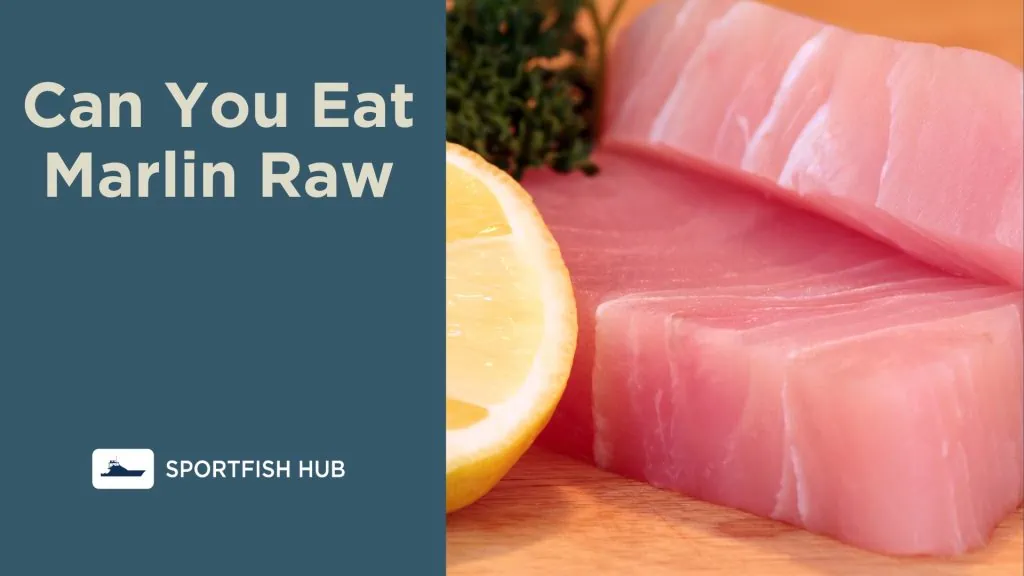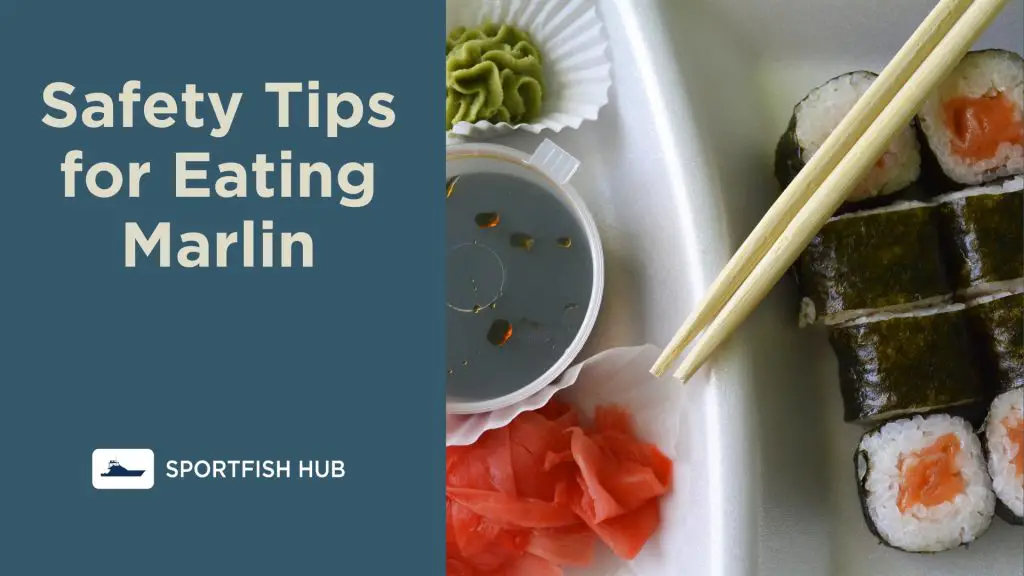Marlin is a large, predatory sport fish pursued by anglers around the world. But many people wonder – can you eat marlin, and if so, how does it taste and what’s the best way to prepare blue marlin? This guide covers everything you need to know about eating different types of marlin.
Key Takeaways on Eating Marlin:
- Marlin is edible and provides healthy omega-3s, but should be eaten in moderation due to potential mercury contamination.
- The four main types of marlin (blue, black, striped, and white) vary in taste, texture and edibility.
- Blue marlin is considered to have a mild, slightly sweet flavor with a firm, steak-like texture.
- Marlin can be eaten raw in sashimi and sushi, or cooked by grilling, baking, pan-searing, or smoking blue marlin.
- Pregnant women, nursing mothers and young children should avoid eating marlin due to mercury content.
Table of Contents
- Key Takeaways on Eating Marlin:
- Do People Eat Blue Marlin and Is It Safe?
- Helpful Video To Watch:
- What Does Marlin Taste Like and Which Type of Marlin Taste Good?
- Blue Marlin Taste (Good To Eat)
- Black Marlin
- Striped Marlin (Best Marlin to Eat)
- White Marlin
- How Does Marlin Compare to Swordfish?
- How To Prepare Blue Marlin and Other Species
- Can You Eat Marlin Raw?
- Is Marlin Safe to Eat? Health Benefits and Risks
- Safety Tips for Eating Marlin
- Frequently Asked Questions About Eating Marlin
Do People Eat Blue Marlin and Is It Safe?
Despite being highly valued as a prized game fish, blue marlin is also eaten in many parts of the world, especially in Hawaii, Japan, and Mexico.
Marlin meat, especially that of blue marlin, is especially popular for its firm texture and mild, slightly sweet flavor. However, as large, predatory fish, they also tend to accumulate mercury and other toxins.
The FDA recommends limiting the intake of high-mercury fish like marlin. Pregnant or nursing women and young children should avoid it completely. For others, eating blue marlin in moderation, around 1-2 times per month, is considered safe to eat.
Helpful Video To Watch:
What Does Marlin Taste Like and Which Type of Marlin Taste Good?
There are four main species of marlin that vary in their taste and texture:
Blue Marlin Taste (Good To Eat)
Blue marlin is considered to have a mild, slightly sweet flavor with a firm, steak-like texture. The flesh is pink to red. It has a moderate “fishy” taste and is excellent for grilling, smoking, or eating raw.
Check out more on the difference between Black Marlin and Blue Marlin.
Black Marlin
Yes, you can also eat black marlin, although it is probably not considered the best marlin to eat. The flesh has a stronger, fishier flavor and moderate fat content. Black marlin (should you decide to try it) is best when grilling, smoking, or in stews and chowders.
Striped Marlin (Best Marlin to Eat)
Growing up to 300 pounds, stripers have a pale pink flesh often described as the best-tasting marlin. The meat is tender, moist and delicately sweet. Raw striped marlin is especially popular for sushi.
White Marlin
The smallest marlin, rarely exceeding 160 pounds. White marlin is not as widely eaten due to its softer texture. When cooked carefully, it has a milder, sweeter flavor than many fish.

How Does Marlin Compare to Swordfish?
Marlin and swordfish have some similarities – they both have a meaty texture and moderate, fishy flavor. But they also have their differences when it comes to taste and culinary uses.
Swordfish is milder in flavor and not quite as firm as marlin. Its extra fat content makes it excellent for grilling. Marlin has a slightly sweeter, more pronounced taste and denser flesh.
Want to know more about how these two fish stack up? Check out this handy guide comparing swordfish vs. marlin in terms of taste, nutrition, mercury levels and more. You may be surprised at how they differ!
How To Prepare Blue Marlin and Other Species
Marlin is a versatile fish that can be prepared in endless ways:

Can You Eat Marlin Raw?
Marlin can be eaten raw in sushi and sashimi, but it should be frozen first to kill parasites. Pregnant women and children should completely avoid raw marlin.
Grilled
A simple preparation is to coat marlin steaks with olive oil, herbs and spices, then grill 3-5 minutes per side. Goes well with citrus butter.
Baked
Baked marlin stays moist and flaky. Coat fillets with spices or marinade and bake at 400°F for 10-15 minutes until opaque. Pair with roasted veggies.
Pan-Seared
Cook marlin fillets or steaks in a hot pan with oil for 2-3 minutes per side to develop a nice crust while keeping the interior moist.
Smoked
An excellent way to prepare firm marlin like blues. Brine first to retain moisture, then smoke for 2-3 hours until flaky. Enjoy as smoked marlin dip or tacos.
Is Marlin Safe to Eat? Health Benefits and Risks
Marlin provides an array of nutrients including:
- High-quality protein for building muscle and repairing tissue.
- Omega-3 fatty acids to reduce inflammation and heart disease risk.
- Vitamin B12, selenium, and other vitamins and minerals.
However, the large size and predatory nature of marlin leads to accumulation of mercury and toxins. Pregnant or nursing women, and children under 12 should avoid marlin completely due to potential mercury exposure.
For healthy adults, the benefits outweigh the risks when eaten occasionally in moderation. Limit intake to 1-2 servings per month along with other low-mercury fish.

Safety Tips for Eating Marlin
To enjoy marlin as safely as possible:
- Confirm it was caught from unpolluted waters to avoid contamination.
- Check for proper refrigeration and freshness before purchasing or eating.
- Freeze first if consuming raw to kill any parasites present. Thaw in fridge before use.
- Cook to an internal temperature of at least 145°F to destroy bacteria and pathogens.
- Avoid cross-contamination by using separate cutting boards and utensils for marlin.
- Clean hands, surfaces, and tools thoroughly after handling.
- Store leftovers in a sealed container for no more than 3-4 days.
Following basic food safety practices reduces your risk when eating this large predatory fish.
Frequently Asked Questions About Eating Marlin
Where do people eat blue marlin?
Blue marlin is eaten worldwide, especially in Hawaii, Japan, Mexico and other coastal regions where marlin fishing is popular.
Is Marlin on of the Largest Fish in the Sea?
Yes, Marlin, especially Black and Blue Marlin are considered some of the biggest fish in the sea, reaching length up to 14ft and potentially 2,000 pounds.












